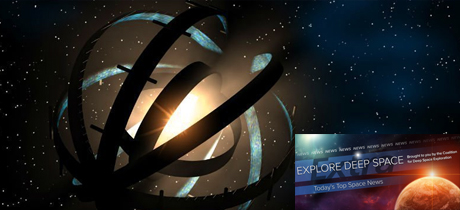Details of NASA’s proposed 2018 budget, along with those of other federal agencies, are anticipated from the White House on Tuesday.
Human Deep Space Exploration
2018 budget proposal to spread cuts across NASA programs
Space News (5/20): The Trump Administration is expected to fill in the details of its proposed 2018 federal budget, in which NASA is expected to receive about $19.1 billion overall, the total first released by the White House in a March budget blueprint. The space agency faces more than $560 million in cuts across individual programs when compared to the 2017 omnibus spending measure enacted earlier this month, according to documentation published May 18 by the Third Wave think tank.
Jeff Bezos lays out his vision for building a city on the moon, complete with robots
Space News (5/21): In remarks to children gathered at the Apollo exhibit at Seattle’s Museum of Flight, Blue Origin founder Jeff Bezos describes his vision for a future industrial settlement at one of the moon’s poles. “It’s time to go back to the moon. But this time to stay,” said Bezos.
Space Science
Juno spacecraft has close encounter with Jupiter’s cloud tops in 6th flyby
Space.com (5/19): NASA’s Jupiter-orbiting Juno spacecraft skimmed over the giant planet’s cloud tops for the sixth time on Friday, coming as close as 2,200 miles. The fast-paced close-ups are intended to reveal more about the planet’s atmosphere, aurora, magnetic field and other details that may help to further explain where Jupiter formed and its influence on the architecture of the solar system. The fly-bys are occurring every 53 days.
‘Alien Megastructure’ star is at it again with the strange dimming
Space.com (5/19): Astronomers are again speculating on the periodic dimming of the star KIC 8462852, also nicknamed “Tabby’s star,” for Yale astronomer Tabetha Boyajian, who led the team that first detected the star’s fluctuations. Some have suggested an artificial structure around the star called a Dyson sphere, rather than natural phenomena, is responsible for the changes in brightness.
Low Earth Orbit
NASA plans emergency spacewalk on International Space Station
Reuters (5/21): NASA announced Sunday that astronauts Peggy Whitson and Jack Fischer will carry out a contingency spacewalk early Tuesday to replace a failed Multiplexer Demultiplexer (MDM), or computer data relay box, outside the International Space Station. The unit failed Saturday. The spacewalk is expected to take about two hours. MDM redundancy prevented the failure from disrupting operations in solar power, cooling, communications and other important systems.
Orbital ATK discusses Antares rocket’s future, confirms new NASA cargo mission
Planetary Society (5/19): Orbital ATK, one of three U.S. companies awarded contracts by NASA in early 2016 to re-supply the International Space Station between 2019 and 2024, intends to continue use of the Antares launch vehicle. The strategy will make Orbital the least expensive of NASA’s three re-supply services over the five year period. The combined value of the NASA contracts for cargo deliveries by Orbital, SpaceX and Sierra Nevada is $14 billion.
Air Force lays out its case for keeping space operations
Space News (5/19): U.S. Air Force Chief of Staff General David Goldfein offered opposition to establishing a separate “Space Corps” within the Air Force in testimony before the U.S. Senate Armed Services Committee’s strategic forces subcommittee. The timing for such a move is not right, when the nation’s military is trying to address threats from space posed by potential adversaries, he testified.
NASA’s Foale, Ochoa welcomed into Astronaut Hall of Fame
Florida Today (5/19): In ceremonies Friday at NASA’s Kennedy Space Center, NASA astronauts Ellen Ochoa and Mike Foale were inducted into the U.S. Astronaut Hall of Fame. They join 93 others dating back to the Mercury era.
China’s Tiangong-1 space lab to fall to Earth between October 2017 and April 2018
GB Times (5/19): China has informed the U.N. that the country’s eight metric ton Tiangong 1 space lab is forecast to re-enter the Earth’s atmosphere between October 2017 and August 2018. Launched in September 2011, Tiangong housed two three-person crews of Chinese astronauts as a precursor to a permanently staffed station, whose orbital assembly is to begin by early 2019.
Suborbital
All booked: Virgin Galactic says suborbital spaceflights are full until 2021
Space News (5/19): A Virgin Galactic executive says the suborbital launch services company has about 650 tourist flight reservations, enough to fill flights until 2021 — if commercial flights begin in 2018.
The Week Ahead
What’s happening in space policy May 22-27, 2017
Spacepolicyonline.com (5/21): The White House is expected to provide Congress with details of the administration’s proposed 2018 budget on Tuesday, including those for NASA, NOAA and civil and military space activities. The White House provided a broad outline or “skinny” budget in March, which included just under $19.1 billion for NASA, down from the $19.65 billion NASA is receiving for the 2017 fiscal year that ends September 30. Also, NASA plans a contingency spacewalk outside the International Space Station early Tuesday to replace a crucial data relay box.

